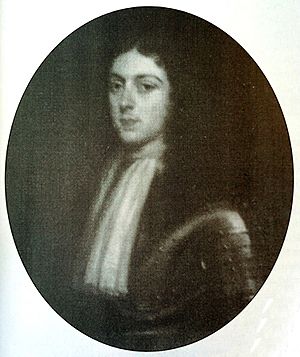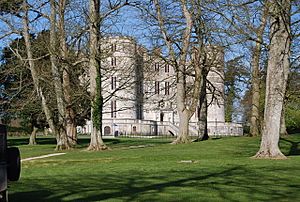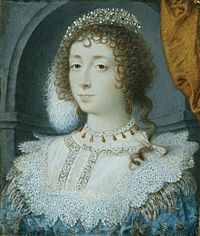Humphrey Weld (of Lulworth) facts for kids
Quick facts for kids
Humphrey Weld
|
|
|---|---|
| Monarch | Charles II |
| Governor of Portland Castle, Keeper of Sandsfoot Castle | |
| In office 1660–1667 |
|
| Member of Parliament for Christchurch (UK Parliament constituency) |
|
| In office 1661 – August 1679 |
|
| Gentleman of the Privy Chamber | |
| In office 1668–1685 |
|
| Recusancy Commission | |
| In office March 1675 – July 1675 |
|
| Personal details | |
| Born | 22 January 1612 Edmonton, Middlesex |
| Died | 10 November 1685 (aged 73) London |
| Resting place | possibly Henry VII Chapel, Westminster Abbey |
| Nationality | English |
| Spouse | Clare Arundell |
| Relations | Sir Humphrey Weld, Thomas Arundell, 1st Baron Arundell of Wardour, 2nd Earl of Carlingford, Sir John Weld (died 1681) |
| Children | Mary Weld Lady Carlingford |
| Parents | Sir John Weld; Frances Whitmore |
| Alma mater | Trinity College, Cambridge |
| Occupation | Lawyer, landowner, art collector and politician |
Humphrey Weld (born January 22, 1612 – died 1685) was an important English lawyer, landowner, and politician. He was also a Deputy Lieutenant (a representative of the Crown in a county) and a Justice of the Peace (a local judge).
Humphrey Weld was secretly a Roman Catholic during a time when it was difficult to hold public office if you weren't Protestant. He kept his religion quiet to stay in his roles. He worked for the Royal family, first as a Cup-bearer for the Catholic Queen Henrietta Maria (King Charles II's mother) and later as a Gentleman of the Privy Chamber for King Charles II.
He held many public jobs in different parts of England, including being the governor of Portland Castle in Dorset. In 1641, he bought the large Lulworth Estate in Dorset. His family, the Welds of Lulworth, have lived there for over 350 years.
Contents
Early Life and Education
Humphrey Weld was the first son of Sir John Weld and Frances Whitmore. His family, the Welds and Whitmores, often married each other over many generations. His grandfather, also named Sir Humphrey Weld, was a merchant and once the Lord Mayor of London.
Humphrey studied Law at Trinity College, Cambridge and joined the Inner Temple (a place for lawyers) in 1631. From 1633 to 1636, he went on a "Grand Tour" of Europe. This was a popular trip for young, wealthy men to learn about European culture and art.
Even though his parents and sisters were Protestants, Humphrey and his two brothers married into important Roman Catholic families. They also changed their own religious beliefs to become Catholic.
Life and Career
When Humphrey Weld returned to London from his European tour, he quickly started his official career. In 1639, he was appointed as a Cup-bearer in the Queen's household. This was a special job serving the Queen.
In 1641, he was listed as a "recusant" for the London Poll tax. A recusant was someone who didn't attend Church of England services, usually because they were Catholic. Letters show that Weld was friends with a Catholic priest named Peter Biddulph. This friendship likely started in Europe and helped Humphrey become an art collector.
Property and Wealth
In 1639 or 1640, Humphrey Weld bought a new mansion in London for £2,600. He called this large house "Weld House." He rented parts of it to rich people, including ambassadors from France, Portugal, and Spain.
In 1641, he bought the huge Lulworth Estate and its castle from Thomas Howard, 3rd Viscount Howard of Bindon for £42,860. This was a very large amount of money at the time.
During the English Civil War, Humphrey Weld spent most of his time with the King's side (the Cavaliers) in Oxford. His own property at Lulworth was taken over by the other side (the Roundheads), who caused some damage to the castle.
After the war, he tried to get money for the damage to his properties. Even though he claimed £2,200 in damages, he was fined £996. This was still a moderate amount for him. He was able to buy many expensive paintings from Europe, even "pieces of devotion" (religious art). Because his servants were also Catholic, he was asked to take a special oath against the Pope, but he managed to avoid it.
Working for the King and Parliament
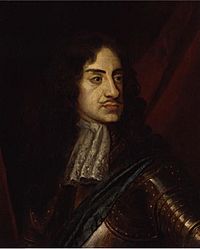
When Charles II became King again (known as the Restoration), Humphrey Weld was made governor of Portland. He also received a secret payment of £1,000 each year for helping the King communicate secretly with the French Royal family.
In 1661, he became a Member of Parliament (MP) for Christchurch. His wife's family owned land there. As an MP, he was not as active as some others. However, as a Justice of the peace in Middlesex, he was very busy and not always popular. Some people complained that he seemed to favor Catholics.
In 1668, he was given a special job in the Royal court as a Gentleman of the Privy Chamber. He kept this job until he died. His secret payment was also restarted. In 1671, a mob attacked "Weld House," shouting angry things. He was saved when a guard patrol arrived.
Facing Accusations
In 1675, Weld was appointed to a commission to deal with "recusants" (Catholics). However, he was removed from it four months later.
During a time called the Popish Plot, there were many false accusations against Catholics. A man named Titus Oates claimed that Humphrey Weld had attended Catholic Mass at "Weld House." Oates also said that Weld had special permission from the Jesuits (a Catholic religious order) to take loyalty oaths, so he could secretly help Catholics in Parliament.
In his only recorded speech in Parliament, Humphrey Weld strongly denied these claims. He said, "I desire to know what I am accused of. I never had Mass in my house in my life, nor went to an ambassador’s house to hear Mass. Let any man spit in my face if he can prove it."
Because of these accusations, Weld lost his position as an MP. He also lost his local government jobs. He had to take out a loan by mortgaging his estates for £4,000.
Public Roles and Appointments
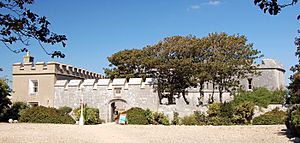
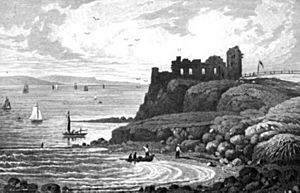
Humphrey Weld held many important roles during his life:
- Justice of the peace for Dorset (1660-1679)
- Justice of the peace for Middlesex (1660-1679)
- Governor of Portland Castle (1660-1679)
- Keeper of Sandsfoot Castle (1660-1665)
- First Member of parliament for Christchurch (1661)
- Commissioner for London (1661)
- Freeman of Weymouth (1661)
- Treasurer for the poor in Middlesex (1664)
- Commissioner for assessing recusants in Hampshire (1675)
Royal Appointments
- Cup-bearer to Queen Henrietta Maria (1639-1644)
- Deputy Lieutenant of Dorset (1665-1679)
- Gentleman of the Privy Chamber (1668-1685)
Family Life
In 1639, Humphrey Weld married Clare (who died in 1691). She was the daughter of Thomas Arundell, 1st Baron Arundell of Wardour. They had one daughter named Mary. Mary later married Nicholas Taaffe, the 2nd Earl of Carlingford.
Humphrey Weld died at the age of 73 in 1685. He was likely buried in the Henry VII Chapel of Westminster Abbey in a secret Roman Catholic service. His nephew, William, inherited his estates.
See also


